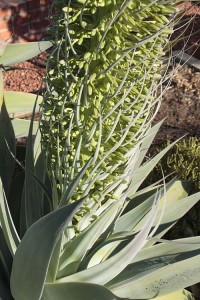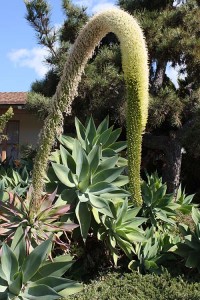Fifteen years I’ve been waiting for this plant to bloom. Fifteen years. And now that it’s blooming it throws its big bloom stalk into a tangle of two tree aloes growing together in what’s now a big three-plant smashup.
The flowering plant is Agave attenuata, the foxtail agave. Native to higher elevations in Mexico, it’s supposedly fairly rare where it originates. But in zone 10 and 9b-plus Southern California gardens it’s fairly common, with several gardens in every block of my neighborhood having one or more plants.
Many agaves, including the local native Shaw’s agave, Agave shawii, come armed with attractive but sharp spines. But A. attenuata is as soft and friendly a succulent as you’ll ever meet, and that’s one of its big appeals for home gardens. Another bonus is that it requires no supplemental watering in gardens near the coast.
Almost all of the agave species will bloom once and then die (monocarpy). Fortunately one plant of this species will have many rosettes, with only the blooming rosette dying back, leaving the rest to bloom in future seasons.
At this point the stalk is taller than I am and is starting to grow downward in a thick arc.
The individual blooms are still closed up for business. Soon, though, the individual greenish white flowers will open up a few at a time, beginning at the base of the inflorescence and then slowly moving towards the end.
Here’s a plant at a neighbor’s house in full bloom last winter so that you can see what the agave does when it isn’t busy running into other plants. Very graceful, don’t you think?
I wish the flowering stem hadn’t collided with the aloes. The stalk is assertive and solid so that there’s no staking it or coaxing it out of harm’s way. Oh well. I can sit back and enjoy the flowering, even if the flowers aren’t in the place where I’d like them.
Anything that you have to wait fifteen years for it to bloom isn’t going to be the most convenient of species.





THAT is an AMAZING plant!
Tree aloes are amenable to having bits trimmed off. The bits will root, and you would have more.
What a spectacular agave bloom! Spectacular agave, too, but those huge bloom heads never fail to amaze me. I’m not familiar with agaves because as far as I know most of them die in zone 8, but I do visit the Huntington Gardens periodically and love seeing their spectacular collection in flower. What fun to get to hang out with them in your own garden, and what a sense of accomplishment to help bring it to flower. Agaves are gorgeous.
I’m sure it’ll be well worth the wait once it really gets going. Keep us posted on the spectacle.
How exciting! Love the first image with the flower wrapped around its tree buddy. Is it fragrant?
Mary Ann, I agree. I never lose my sense of wonder at this agave.
EE, thanks for the tip! My brain somehow thinks of the tree aloes as being so different from the lower-growing ones which I’ve had almost too good of success with propagating.
Pomona, while there are some hardier agaves, such as A. parryi (zone 5), the majority are definitely on the wimpy side–don’t let the spines fool you! I’ve never gone to the Huntington in the winter. I should make a point of it and catch the peak excitement.
Pam, absolutely! I’ll definitely share photos as the stem lengthens and the flowers begin to open.
Lynn, hmmmm, I have no idea whether it’s fragrant. I’ll have to find that out once the flowers open. They do attract various pollinators, so I wouldn’t be surprised if there’s at least some scent.
I’ve never had an agave bloom for me, yet. Pretty cool. We put an A. attenuata in a container in a garden this past week. They’re less common up here.
Looks simply spectacular. I have a small agave attenuata but I think I should get some more.
LOL, James. Man, 15 years is one ton of patience! It is actually hard to imagine your feelings dealing with such a slow grower – do you reflect on the things you were doing when you planted it? I bet it would be hard not to.